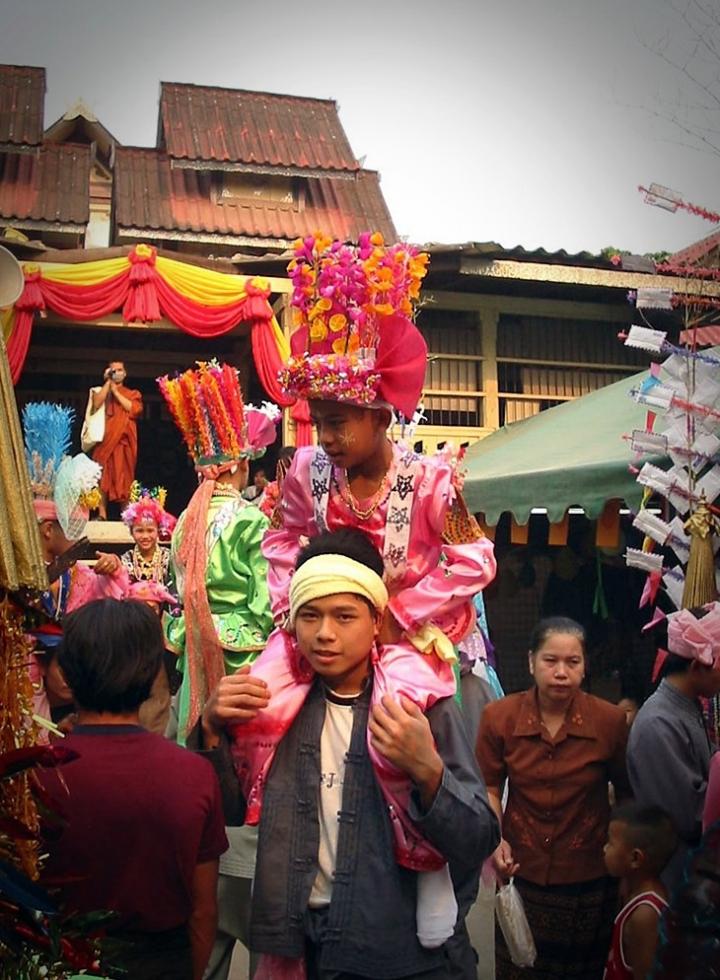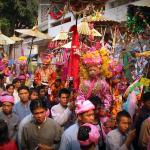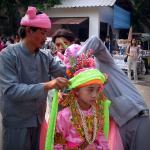It was a quiet summer day that I traveled to Wat Pa Pao temple, the hub of the Shan community on Maneenopparat Road outside the city moat. I was thoroughly enjoying myself taking pictures of the temple when I noticed a local artist writing a signboard in Burmese language.
So I walked up to him and asked what it meant. He didn’t speak good Thai, but nonetheless did his best to tell me that it meant the ‘Poy Lang Long Festival’, the novice ordination ceremony, held at this time of the year. I immediately knew that I would soon be witnessing a procession of boys dressed in colorful costumes arriving at the temple to be ordinated as novice monks.
The temple is designed in Pagan style, which is different from northern Thai style architecture. The most striking feature is a sunken courtyard that was added in 1883 to further the cause of Buddhism, as observed by the Shan.
The temple gates till precariously and the numerous statues of mythical beings lend the place great exotic charm. An unusual feature is the flat ceiling of the ordination hall. The temple has a vaulted interior containing three Buddha statues done in Burmese style. It sits in a small grove of ‘Pao’ trees that gives the temple its name.
At the abbot’s residence I had an opportunity to converse with Uncle Thongkham Supachaiya, 74, the community headman. I was told that his father and kin migrated to Chiangmai when he was only 10. Like others, his father left Shan state in Burma because of economic hardship and came to Thailand in search of work and better life.
“The community comprises of 65 Shan and a few Thai families. A lot of them married into Thai families and took up Thai citizenship. The Shans highly respect elders in society,” he said.
The Tourism Authority of Thailand (TAT) has lent its support to the Shan-style ordination and now it’s a regular fixture on Chiangmai’s tourism calendar.
When Shan boys reach the age of 12 they enter monkhood for a short period. Some become monks again later but for a longer period. The underlying belief is that physical and spiritual aspects of men are closely intertwined.
Wearing colorful traditional costume and ornaments, Shan youths gather for pre-ordination rites. Poy Sang Long is now and annual event lasting three days. “Poy” in Shan dialect means merit-making, while “Sang Long” means Buddhist novice.
Boys have their head shaven by their parents and relatives, but not heir eyebrows (different from Thai monks). Then they bathe in herbal water before spending the night with their parents, their last at home before the ordination.
Poy Sang Long is a family festival. Boys visit relatives and elders and ask for their forgiveness for past offence or misbehavior. They are eagerly greeted as it is believed that the novices will bring their family and friends good luck.
On the day of the ceremony Shan people wear their colorful traditional costume. Women wear a wrap-around tube skirt called the ‘long-yi ‘or ‘sa-rong’ and snugly fitting blouse, and tie their hair in a bun. Men wear baggy trousers. Chinese style shirt, and sometimes a turban.
On the first day of the festival, boys get a makeover with powder, rouge and lipstick. They then dress up in glistening white costume, necklace and ornaments. Each boy wears Burmese-style turban decorated with colorful flowers. They are now called “look Kaew” which translates into something like “pure as crystal”. Each of them are assigned tow aides, one to carry the boy on his shoulders (originally they rode pony), and another to carry the umbrella to offer him shade from the sun. The boys are now referred to as the “Sons of Heaven” and their feet should not touch the ground.
The festival begins with the Sang Long procession to the temple led by musicians, with relatives of the boys trailing behind in all their finery. Once there, the boys and the marchers make three rounds around the courtyard before entering the monastery hall.
The boys then seek permission from the elders to be ordained as monk. Once granted, they start the process of removing their make –up and colorful costumes and change into saffron robes. For the boys, it’s an experience that will last a life time.
Poy Sang Long is the finest example of the rich cultural heritage of Shan people. Tourists visiting Chiangmai are welcome to share this delightful experience of Wat Pa Pao and related activities as Tha Pae Gate.
 ThingsAsian
ThingsAsian




















